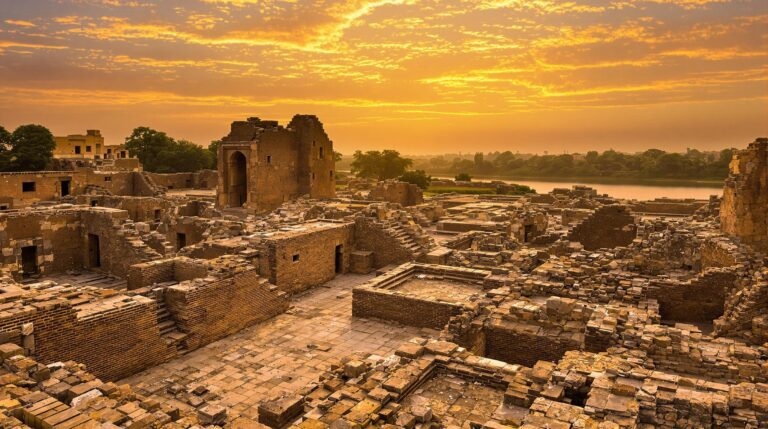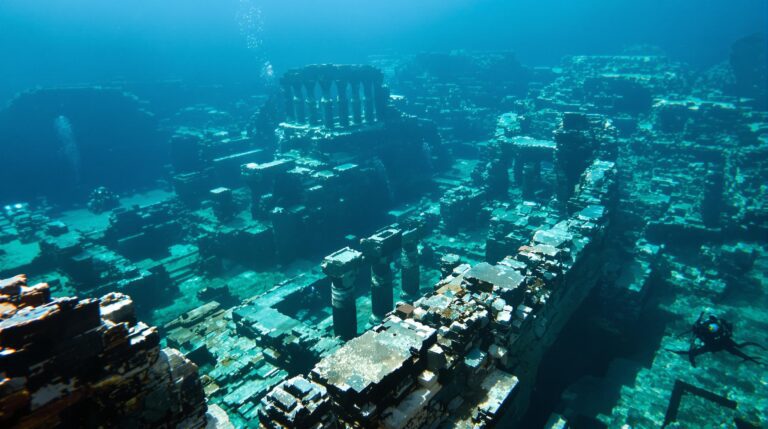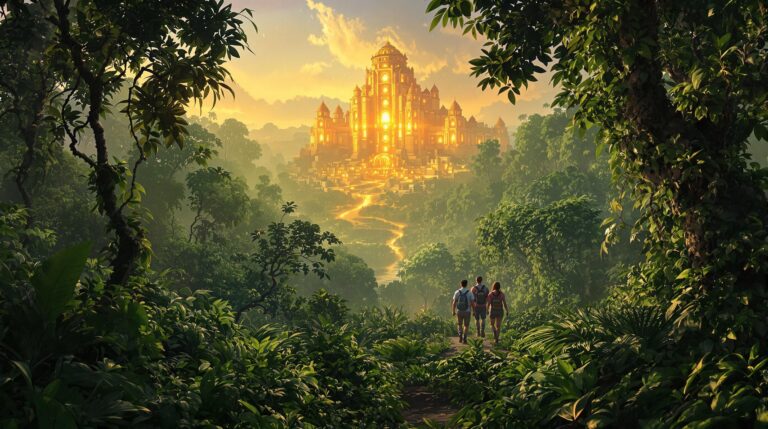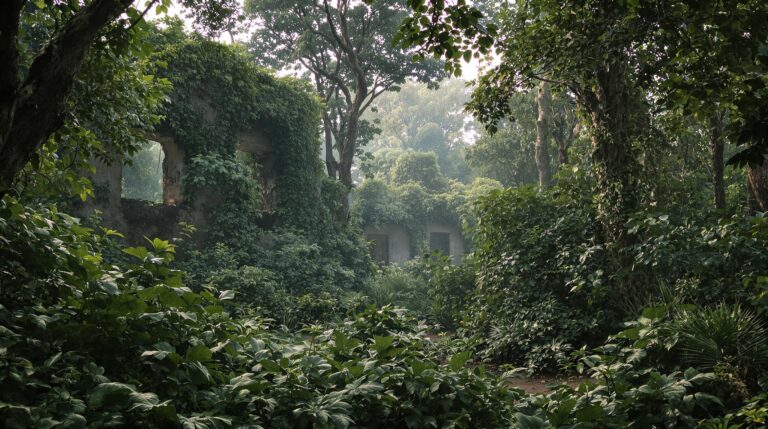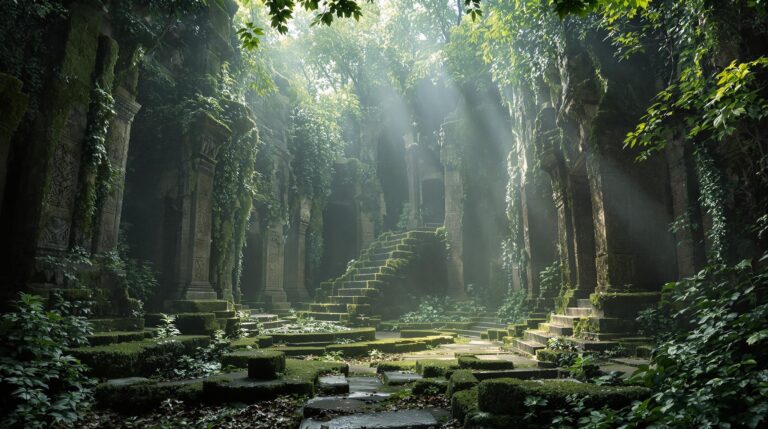Ciudad Perdida: Colombia’s Lost Jungle City
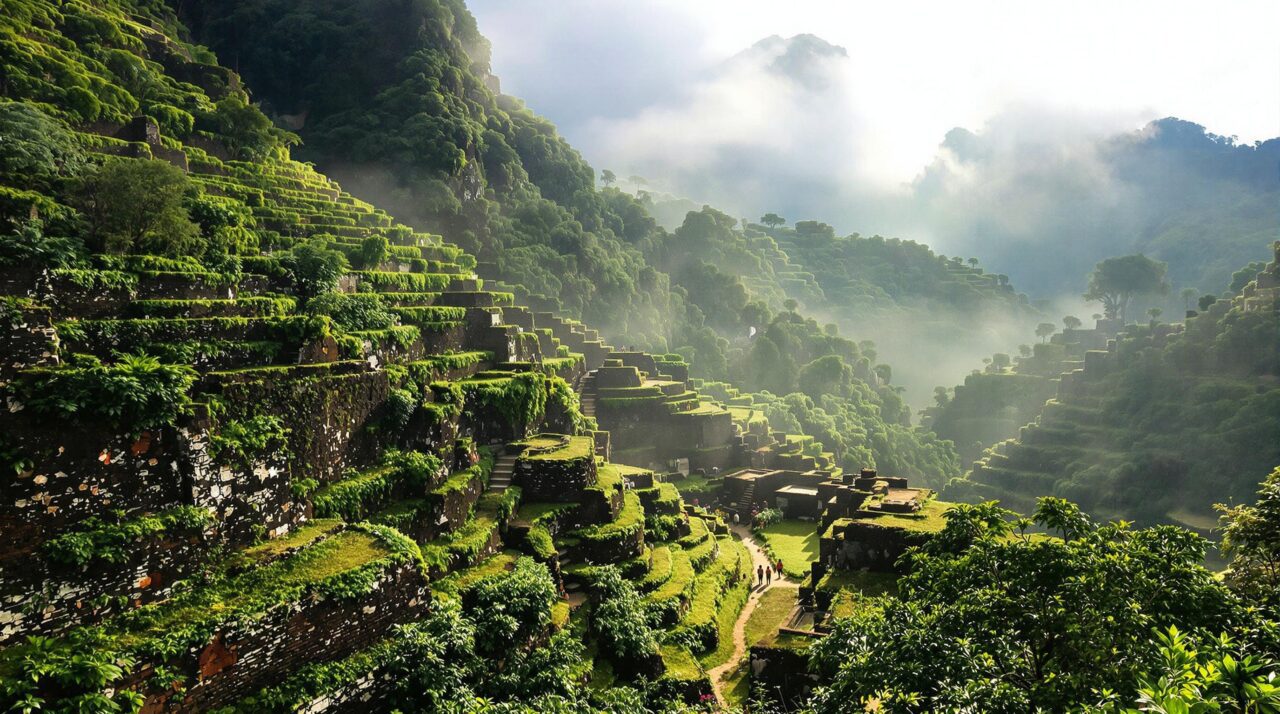
Colombia’s Lost City, nestled within the Sierra Nevada de Santa Marta, stands as a monument to the advanced civilization of the Tayrona culture.
Its rediscovery highlights a complex interplay of history and nature, revealing not just architectural brilliance but also a deep connection to the land.
As interest in this ancient site surges, questions arise about the impact on local communities and the balance between preservation and tourism.
What unfolds next could reshape the narrative of this hidden gem.
Summary & Key Takeaways
Hide- Colombia's Lost City, or Ciudad Perdida, was rediscovered in the 1970s through the efforts of local guides and hunters.
- The site showcases the sophisticated Tayrona culture, with advanced agricultural practices and intricate trade networks evident in its architecture.
- Trekking to the Lost City involves navigating dense forests and rugged terrain, providing a link between modern adventurers and ancient civilizations.
- Increased tourism has led to economic transformation for local communities, fostering sustainable development while preserving indigenous heritage.
- Collaborative efforts between researchers and indigenous groups aim to protect the site and empower local populations through cultural revival and resource management.
Discovery and Historical Background of Ciudad Perdida
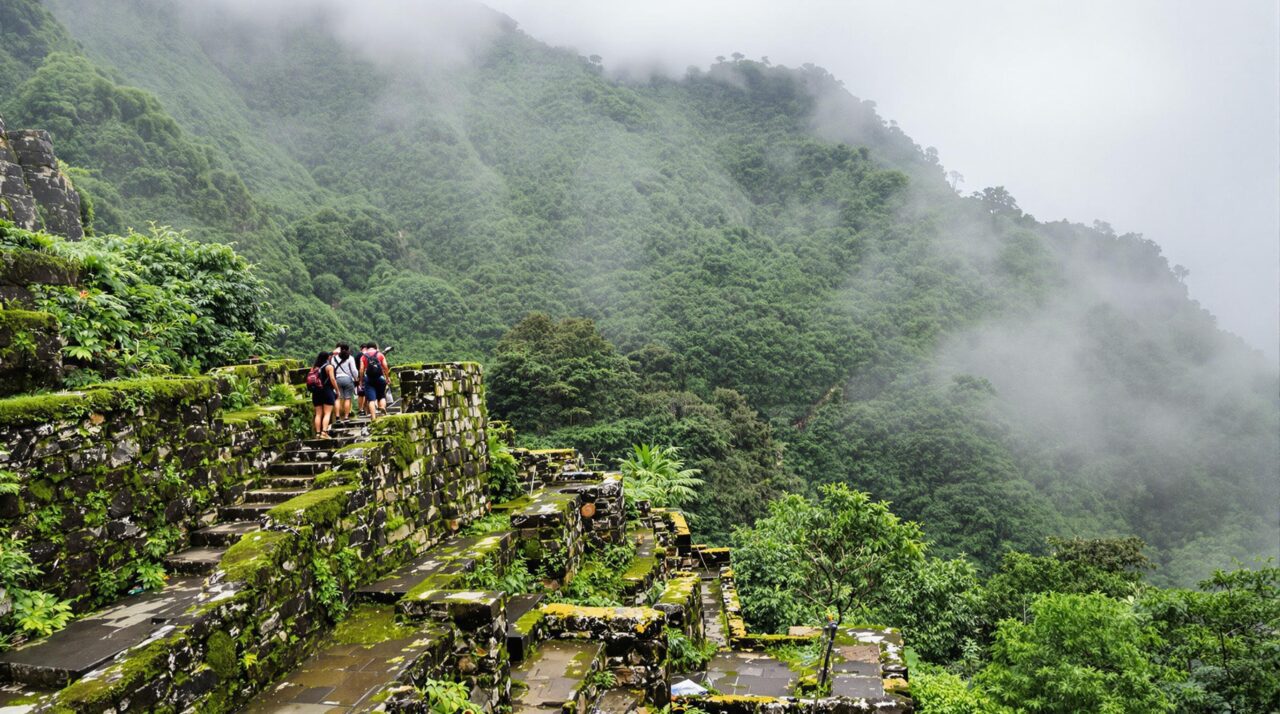
The rediscovery of Colombia’s Lost City can be attributed greatly to the insights of local guides and hunters, whose intimate knowledge of the terrain illuminated paths long obscured by dense jungle.
Their accounts not only sparked interest but also prompted archaeological investigations that confirmed the existence of this ancient site.
This intersection of local expertise and scientific inquiry underscores the importance of collaboration in uncovering historical narratives.
The Role of Local Guides and Hunters
Local guides and hunters played a pivotal role in uncovering the Lost City of Colombia. Their chance encounters within the dense, unyielding vegetation served as the catalyst for its rediscovery.
Initial artifacts, unearthed amidst the foliage, sparked intrigue and drew attention from anthropologists and treasure seekers alike, illuminating a forgotten chapter of history.
This intersection of local knowledge and archaeological curiosity transformed a mere accident into a significant cultural resurgence.
Chance Encounters in Dense Vegetation
Amidst the lush, impenetrable vegetation of Colombia’s jungles, countless chance encounters have revealed the remnants of ancient civilizations.
Local guides and experienced hunters often serve as crucial intermediaries between the past and present.
Their intimate knowledge of the land fosters serendipitous discoveries, intertwining human narratives with the whispers of history, illuminating paths once obscured by nature’s relentless embrace.
Initial Artifacts Leading to Wider Interest
Chance encounters in Colombia’s dense jungles have often led to the discovery of remarkable artifacts, sparking a broader interest in the region’s ancient civilizations.
These initial finds, guided by local hunters, revealed:
- Intricate gold figurines reflecting lost craftsmanship.
- Ceramics adorned with symbols of a forgotten language.
- Burial sites hinting at complex spiritual beliefs.
Each artifact fuels a yearning for understanding and connection to a lost world.
Archaeological Confirmation
The collaboration between government authorities and research teams marked a pivotal moment in the quest to validate the existence of the Lost City in Colombia.
Early excavation efforts in the 1970s laid the groundwork for understanding the site’s historical significance, revealing artifacts and structures that hinted at a once-thriving civilization.
This partnership not only facilitated archaeological exploration but also rekindled interest in the region’s rich cultural heritage.
Government and Research Collaboration
Although the discovery of the Lost City in Colombia was initially the result of chance encounters by treasure hunters, it soon transformed into a significant collaboration between government entities and academic researchers.
This partnership aimed to safeguard the site and unravel its mysteries, leading to:
- Preservation of indigenous heritage.
- Enhanced local community engagement.
- A deeper understanding of pre-Columbian civilizations.
Such efforts embody a quest for freedom through knowledge.
Early Excavation Teams in the 1970s
As the collaboration between government and researchers began to take shape, the 1970s marked a pivotal moment for the Lost City in Colombia.
Early excavation teams, driven by curiosity and a quest for knowledge, unearthed remnants of an ancient civilization.
Their findings not only confirmed the city’s existence but also ignited a fascination with its rich cultural heritage, inviting further exploration and understanding.
Significance to the Tayrona Culture
The Lost City serves as a tribute to the intricate social fabric of the Tayrona culture, highlighting the development of a sophisticated society marked by advanced agricultural practices and trade networks.
Its architectural remnants reveal a deep commitment to community organization and spiritual life, reflecting a vibrant mosaic of religious beliefs intertwined with daily existence.
This site not only underscores the complexity of Tayrona civilization but also invites contemplation of their enduring legacy in the region.
Development of a Complex Society
The Tayrona culture’s development of farming terraces and advanced irrigation systems illustrates their sophisticated understanding of agriculture and environmental management.
These innovations not only supported a stable food supply but also facilitated trade routes through the challenging mountain pathways, enhancing economic and social interactions.
Such advancements were pivotal in establishing a complex society that thrived in the diverse landscapes of Colombia.
Farming Terraces and Advanced Irrigation
Crafting intricate farming terraces and implementing advanced irrigation systems, the Tayrona people showcased remarkable ingenuity in adapting to their environment.
This ingenuity was essential in developing a complex society, allowing them to thrive.
- Enhanced agricultural yield, ensuring food security.
- Strengthened community ties through collaborative farming.
- Fostered a deep connection to the land, nurturing cultural identity.
Trade Routes Through Mountain Pathways
Mountains served as both barriers and conduits for the Tayrona civilization, shaping their trade routes and facilitating cultural exchange.
These pathways forged connections between diverse communities, enabling the flow of goods, ideas, and traditions.
The intricate network not only supported economic prosperity but also fostered a rich cultural tapestry, ultimately contributing to the development of a complex society that thrived in harmony with its environment.
Religious and Community Structures
The religious and community structures of the Tayrona culture reveal a profound connection between their social organization and spiritual beliefs.
Terraced platforms, likely used for ceremonial purposes, underscore the importance of communal gatherings in reinforcing cultural identity.
Additionally, artifacts unearthed from these sites offer intriguing insights into the spiritual life of the Tayrona, suggesting a vibrant mosaic of beliefs that shaped their worldview.
Terraced Platforms for Ceremonies
In the intricate tapestry of Tayrona culture, terraced platforms served as pivotal sites for ceremonial gatherings, reflecting the community’s deep-rooted spiritual beliefs and social hierarchies.
These sacred spaces symbolized:
- Unity: A collective bond among community members, reinforcing shared identity.
- Ritual: The enactment of traditions that honored ancestral connections.
- Hierarchy: A physical representation of social structures, guiding the community’s spiritual journey.
Hints of Spiritual Beliefs in Artifacts
Artifacts unearthed from the Tayrona civilization offer profound insights into the community’s spiritual beliefs and social structures, revealing a complex mosaic of religious practices intertwined with daily life.
Intricate pottery, ceremonial masks, and stone carvings reflect a reverence for nature and ancestors.
These relics suggest a society where spirituality permeated existence, fostering unity and enriching the cultural identity of the Tayrona people.
Journey Through the Dense Forest
The trek through the Sierra Nevada de Santa Marta presents a formidable challenge, as dense foliage and rugged terrain envelop explorers in a world untouched by time.
Camps along the route serve as essential points of respite, fostering a connection between modern adventurers and the ancient Tayrona civilization that once thrived in this lush expanse.
Preservation efforts are critical, ensuring that this sacred landscape remains a proof of both nature’s grandeur and cultural heritage.
Trekking the Sierra Nevada de Santa Marta
Trekking through the Sierra Nevada de Santa Marta presents a formidable challenge, characterized by steep trails and frequent river crossings that test the mettle of even seasoned adventurers.
The journey is not just a physical endeavor; it offers a unique opportunity to encounter diverse wildlife, each moment steeped in the pulse of the dense forest.
As trekkers navigate this rugged terrain, they confront both the beauty and the trials of nature, creating an experience that is as transformative as it is demanding.
Steep Trails, River Crossings, and Wildlife
Amidst the rugged terrain of the Sierra Nevada de Santa Marta, adventurers encounter a plethora of steep trails that challenge both the body and the spirit.
Each bend reveals breathtaking landscapes, while river crossings invigorate the senses.
Wildlife thrives in this lively ecosystem, offering glimpses of:
- Colorful birds soaring above.
- Playful monkeys swinging through trees.
- Majestic waterfalls cascading down.
Each moment ignites a yearning for freedom.
Challenges Adventurers Face on the Route
Maneuvering through the dense forests of the Sierra Nevada de Santa Marta presents unique challenges that test even the most seasoned adventurers.
Thick undergrowth obscures trails, while sudden rainstorms turn paths into slippery mudslides. Additionally, the risk of wildlife encounters heightens the tension, demanding vigilance.
Together, these obstacles not only require physical endurance but also a mental fortitude, forging a deeper connection with nature’s untamed spirit.
Camps and Preservation Efforts
In the heart of the Sierra Nevada de Santa Marta, the management of tourist access to the Lost City emerges as a critical concern.
With strict limits on visitor numbers, efforts aim to balance the allure of sustainable tourism with the necessity of preserving the delicate ecosystem and cultural heritage.
This careful orchestration not only protects the site but also enhances the experience for those who journey through its dense, ancient forests.
Limits on Tourist Numbers
While the allure of the Lost City captivates adventurers and history enthusiasts alike, the Colombian authorities have imposed strict limits on tourist numbers to safeguard its delicate ecosystem and cultural heritage.
This approach aims to:
- Preserve the ancient ruins for future generations.
- Protect diverse flora and fauna in the surrounding rainforest.
- Enhance the visitor experience by reducing overcrowding.
Such measures serve both conservation and connection.
Balancing Sustainable Tourism with Protection
To guarantee the preservation of the Lost City and its surroundings, a delicate balance between sustainable tourism and environmental protection is paramount.
Initiatives such as eco-friendly camps and guided tours foster responsible exploration, allowing visitors to connect with nature without compromising its integrity.
Architectural Marvels Among the Trees
The Lost City of Colombia, shrouded in dense foliage, reveals an intricate tapestry of stone steps and pathways that once guided its inhabitants through the verdant landscape.
These architectural remnants not only underscore the ingenuity of its builders but also hint at the hidden ruins and unexplored areas that lie waiting for discovery.
Each structure, entwined with nature, invites a deeper understanding of the civilization that thrived amidst the towering trees.
Stone Steps and Pathways
The stone steps and pathways of the Lost City in Colombia stand as remarkable demonstrations of the architectural ingenuity of its creators.
These massive staircases not only facilitate movement between key zones but also reveal a sophisticated understanding of city planning, intricately woven into the lush forest environment.
Each pathway tells a story, hinting at the lively life that once thrived amid the towering trees.
Massive Staircases Linking Key Zones
Amidst the dense foliage of Colombia’s lost city, massive staircases emerge as striking architectural marvels, seamlessly integrating human ingenuity with the natural landscape.
These stone structures whisper tales of connection, purpose, and resilience:
- Unity – Linking diverse zones, they symbolize the city’s harmony.
- Endurance – Withstanding time, they evoke a sense of reverence.
- Exploration – Inviting wanderers to discover hidden wonders.
Intricate Design Hinting at City Planning
Massive staircases not only facilitate movement through the lush terrain but also reveal an intricate design that speaks to the city’s sophisticated planning.
Each stone step, meticulously crafted, hints at a deep understanding of the landscape, integrating functionality with artistry.
The pathways intertwine seamlessly with nature, showcasing an architectural marvel that invites exploration and evokes a sense of wonder at the ingenuity of its creators.
Hidden Ruins and Unexplored Areas
Amidst the dense foliage of Colombia’s Lost City, ongoing discoveries reveal the remnants of hidden ruins that hint at a rich, untold history.
Each excavation brings forth new architectural marvels, suggesting that significant portions of this ancient civilization remain untouched and waiting to be uncovered.
The potential for further exploration not only captivates researchers but also ignites the imagination of those intrigued by the mysteries that lie beneath the canopy.
Ongoing Discoveries in Remote Parts of the Site
As researchers explore deeper into the dense jungles surrounding Colombia’s Lost City, new architectural marvels continue to emerge, revealing a complex tapestry of human ingenuity hidden beneath the foliage.
These discoveries inspire wonder and curiosity:
- Intricate stone pathways weaving through thick vegetation.
- Monumental terraces overlooking lush valleys.
- Elaborate ceremonial sites hinting at rich cultural practices.
Each finding beckons a deeper understanding of this ancient civilization.
Potential for Further Excavations
The discoveries made in the dense jungles surrounding Colombia’s Lost City suggest that vast areas remain uncharted and ripe for exploration.
Architectural marvels, obscured by nature’s embrace, beckon archaeologists and adventurers alike. Each excavation promises to reveal intricate stone structures and artifacts, offering deeper insights into ancient civilizations.
The potential for further excavations ignites a passionate pursuit of knowledge and liberation from historical obscurity.
Local Communities and Cultural Revival
The resurgence of interest in Colombia’s Lost City has sparked a profound reconnection between present-day indigenous communities and their ancestral heritage.
As these groups reclaim their cultural narratives, they simultaneously navigate the economic and social impacts of increased tourism, which brings both opportunities and challenges.
This dynamic interplay highlights the importance of preserving identity while adapting to contemporary realities.
Present-Day Indigenous Connections
The revival of indigenous culture in present-day Colombia showcases a profound commitment to respecting ancestral customs and traditions.
Local communities are forging partnerships aimed at sustainable resource management, bridging the gap between ancient practices and contemporary environmental stewardship.
This dynamic interplay not only enriches cultural identity but also fosters a renewed sense of agency among indigenous groups in the region.
Respecting Indigenous Customs and Traditions
While exploring the intricate fabric of Colombia’s Lost City, one cannot overlook the profound significance of respecting Indigenous customs and traditions that shape the lives of local communities.
Embracing these practices fosters cultural revival and mutual understanding.
Key elements include:
- Spiritual ceremonies that honor ancestral connections.
- Traditional crafts that preserve unique identities.
- Oral histories that transmit wisdom across generations.
These aspects empower and liberate.
Partnerships for Resource Management
As local communities in Colombia’s Lost City navigate the complexities of modern resource management, partnerships with Indigenous groups emerge as an essential strategy for cultural revival and environmental stewardship.
These collaborations foster a resurgence of traditional practices, ensuring sustainable land use while honoring ancestral knowledge.
Such alliances not only empower Indigenous voices but also promote a shared vision of harmony between humanity and nature, important for future generations.
Economic and Social Impact
The resurgence of the Lost City as an ecotourism destination has begun to transform the economic landscape for nearby villages, offering new avenues for income and sustainable development.
This influx of visitors not only provides financial benefits but also fosters a renewed appreciation for ancestral identities, allowing local communities to reclaim and celebrate their cultural heritage.
As these villages engage with tourists, they navigate the delicate balance between economic growth and the preservation of their unique traditions.
Ecotourism Benefits for Nearby Villages
Given the increasing popularity of ecotourism, nearby villages of the Lost City in Colombia are experiencing a significant transformation, both economically and socially.
This resurgence fosters:
- Economic growth through sustainable tourism jobs.
- Cultural exchange that enriches local traditions and practices.
- Community empowerment, as residents take ownership of their heritage.
These factors collectively enhance the villagers’ quality of life and invigorate their cultural identity.
Preservation of Ancestral Identities
With the rise of ecotourism, local communities surrounding the Lost City in Colombia are increasingly prioritizing the preservation of their ancestral identities.
This cultural revival fosters a sense of pride, empowering residents to reclaim their heritage.
Wrapping Up
Amidst the emerald canopy, Colombia’s Lost City stands as a tribute to the resilience of the Tayrona culture, its ancient stones entwined with roots and vines, whispering stories of a lively past.
As sunlight filters through the leaves, illuminating the remnants of intricate pathways and terraced fields, the site breathes life into a cultural renaissance.
This delicate balance of heritage and ecotourism not only honors the ancestors but also nurtures a profound connection between the land and its people.
